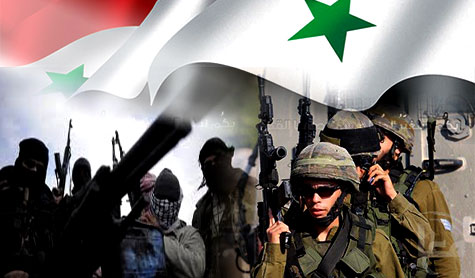
The “Israeli” Role in Quneitra’s Outskirts

Hussein Mourtada
While the Syrian Army soldiers have not finished from cleaning up the rocky enclaves on the Syrian-Lebanese border in the Qalamoun area, the signs of confusion have come to be displayed on the groups militants in different areas, including Quneitra-particularly on the foothills of Mount Hermon near the barbed wire on the border with occupied Golan.
The battles and the clashes in that area cannot hide the "Israeli" dealings with the military event there. The role of the "Israeli" army increased after the establishment of a central operations room, led by Abdul Ilah al-Bashir al-Naimi, commander of the so-called "Military Council" who owns coordination lines with leaders in the "Israeli" army.

This came following the establishment of assembly points for the reception of wounded armed groups on the banks of the Tiberias beach- allowing for the militants to move about and bring logistical support from Jordan, and opening the door of the battles along the front of Quneitra's outskirts to reduce the pressure on the armed groups in Old Homs and Aleppo.
However, the "Israeli" entity began a new phase in providing support to armed groups. It was not enough for it to provide logistical facilitations , for it also pushed the Chief of the General Staff of the "Israeli" army, Benny Gantz, for a new, special regional military unit called, ‘Bashan', in the occupied Golan and in direct contact with armed groups. This unit is a previous backup unit, which was returned to serve with the occupation army in the sites in the front sites of the Golan Heights and Mount Hermon.
It is remarkable and worth contemplating over the name of the military unit that has been tasked to communicate with the armed groups on the border with occupied Golan, whereby the name, ‘Bashan', in Hebrew means, "the smoothed, flat ground." Historically, it is a county in the land of Canaan which includes occupied Golan, Houran and Lajat, of which all of them are made up of rocks and volcanic dust.
Its soil is very fertile, and its water is abundant. It is bordered by the territory of Damascus to the north, the Syrian desert to the east, the land of Gilead to the south, and the Jordan River to the west. Mount As-Suwayda runs through its eastern side, which is the old Bashan mountain and a series of hills pass through the Golan from north to south is an old dormant volcanoes.
The province of Lajat is a field of volcanic rock that has spilled over from Seyhan hill, which is the mouth of an ancient volcano. According to what is stated in the Old Testament, ‘Bashan' is mentioned about sixty times in the Bible. The symbolic name indicates that the unit is the focus of its work throughout that region.
In a clear reference to the so-called wall -Tayeb, wherein the intelligence in the "Israeli" entity in addition to the occupation army through the Yachan unit, began work to create a favorable environment for him after persuading many of the armed groups present in that region due to its strategic importance, where the entity's leader spends away in supporting the armed groups with Takfiri to become active in guarding the Zionist soldiers who contributed to the cleaning of lands adjacent to the border from the mines, and facilitated the passage of armed groups from the western outskirts of Daraa, particularly the area of Tel Jabiya nuclei towards him and towards the Tel al-Hoss and Tel al-Majameea'.
This unit is one of the components of the so-called "leadership of the northern region in the "Israeli" army, which is backed by the intelligence system (MARS) and equipped with a digital sensor. The head of the Northern Command in the "Israeli" forces, General Yair Golan, has said: "We have created this military unit in the Golan Heights and set them up with the best forces in order to be more prepared than ever." The "Israeli" Channel Ten has said that the "Israeli" special unit, ‘Mitar', is the one that took the task of firing missiles in July "Israeli" toward the Syrian territory , and that this unit is continuously considering to conduct military operations in Quneitra and its outskirts. It also tries to guide the armed groups to prevent the Syrian army from progressing and restoring the villages adjacent to the borders with occupied lands.
However, despite all of that, the Syrian army was still able to direct hard strikes at the armed groups in that region, and deal with it at the level of several axes; in terms of high combat capability was the latest ambush that the Syrian army set up for one of these groups on the road between Sasa and Quneitra's outskirts. This confirms the willingness of the Syrian army to constantly face any developments in the battle, and to quickly deal with all the possibilities of intervention by the "Israeli" entity- which stands helpless in front of the ongoing change in the Syrian army tactics- making it along with its allies from the armed groups that are in a state of confusion.
Source: al-Ahed News



